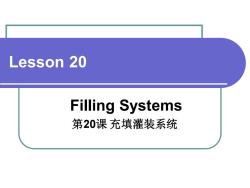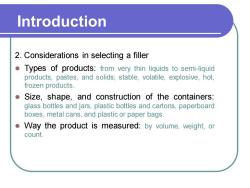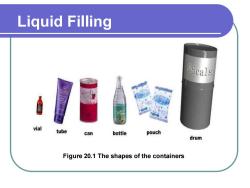陕西科技大学:《包装技术基础 Fundamentals of Packaging Technology》课程PPT教学课件(英文版)Lesson 20 Filling Systems 第20课 充填灌装系统

Lesson 20 Filling Systems 第20课 充填灌装系统
Lesson 20 Filling Systems 第20课 充填灌装系统

content ⚫ Introduction ⚫ Liquid Filling ⚫ Liquid Volumetric Filling ⚫ Liquid Constant Level Filling ⚫ Dry Product Filling ⚫ Dry Volumetric Filling ⚫ Dry Filling By Weight ⚫ Filling By Count
content ⚫ Introduction ⚫ Liquid Filling ⚫ Liquid Volumetric Filling ⚫ Liquid Constant Level Filling ⚫ Dry Product Filling ⚫ Dry Volumetric Filling ⚫ Dry Filling By Weight ⚫ Filling By Count

Introduction 1. What a filler can be asked to do? Fillers, filling machines, are used to transfer many types of products from bulk storage bins and vats into the containers in which they find their way to the market. The great variety of products that are packaged and the containers that they fill has caused the development of a large number of processes, techniques, and machines that are used for product filling
Introduction 1. What a filler can be asked to do? Fillers, filling machines, are used to transfer many types of products from bulk storage bins and vats into the containers in which they find their way to the market. The great variety of products that are packaged and the containers that they fill has caused the development of a large number of processes, techniques, and machines that are used for product filling

2. Considerations in selecting a filler ⚫ Types of products: from very thin liquids to semi-liquid products, pastes, and solids; stable, volatile, explosive, hot, frozen products. ⚫ Size, shape, and construction of the containers: glass bottles and jars, plastic bottles and cartons, paperboard boxes, metal cans, and plastic or paper bags. ⚫ Way the product is measured: by volume, weight, or count. Introduction
2. Considerations in selecting a filler ⚫ Types of products: from very thin liquids to semi-liquid products, pastes, and solids; stable, volatile, explosive, hot, frozen products. ⚫ Size, shape, and construction of the containers: glass bottles and jars, plastic bottles and cartons, paperboard boxes, metal cans, and plastic or paper bags. ⚫ Way the product is measured: by volume, weight, or count. Introduction

Introduction ⚫ Desired speed of the operation: a relatively slow manual operation, semi-automatic, fully automatic ( high speed lines) ⚫ Special handling requirements of the product ⚫ Cost of installation ⚫ Operation
Introduction ⚫ Desired speed of the operation: a relatively slow manual operation, semi-automatic, fully automatic ( high speed lines) ⚫ Special handling requirements of the product ⚫ Cost of installation ⚫ Operation

Liquid Filling 1. Introduction ⚫ Liquid products: alcohol and soda water ⚫ Semi-liquid products: toothpaste, peanut butter, and caulking compound
Liquid Filling 1. Introduction ⚫ Liquid products: alcohol and soda water ⚫ Semi-liquid products: toothpaste, peanut butter, and caulking compound

Liquid Filling 2. Types of Filling Machines ⚫ The containers may be made of plastic, metal, glass, treated paperboard, or a number of other materials. ⚫ The shapes of the containers include those of bottles, jars, vials, tubes, cans, pouches, cartons, and drums (Figure 20.1)
Liquid Filling 2. Types of Filling Machines ⚫ The containers may be made of plastic, metal, glass, treated paperboard, or a number of other materials. ⚫ The shapes of the containers include those of bottles, jars, vials, tubes, cans, pouches, cartons, and drums (Figure 20.1)

Figure 20.1 The shapes of the containers Liquid Filling
Figure 20.1 The shapes of the containers Liquid Filling

⚫ Most liquid and semi-liquid products are filled by one of two major methods: volumetric, or constant level filling. ⚫ In volumetric filling the amount of product is premeasured so that each container has the same volume of product. ⚫ Constant level filling techniques fill each container to the same level, so it is frequently called the “fill-to-a-level” method. Liquid Filling
⚫ Most liquid and semi-liquid products are filled by one of two major methods: volumetric, or constant level filling. ⚫ In volumetric filling the amount of product is premeasured so that each container has the same volume of product. ⚫ Constant level filling techniques fill each container to the same level, so it is frequently called the “fill-to-a-level” method. Liquid Filling

Liquid Filling 3. Use of Filling Machines ⚫ Volumetric filling is particularly appropriate for applications in the pharmaceutical industry where it is important that each container is accurately filled with a specific volume of product. ⚫ Constant level filling is used with see-through bottles in which it is important that all of the bottles in a display appear to be filled to the same level, although the bottles may not be exactly the same size and the volumes may be slightly different
Liquid Filling 3. Use of Filling Machines ⚫ Volumetric filling is particularly appropriate for applications in the pharmaceutical industry where it is important that each container is accurately filled with a specific volume of product. ⚫ Constant level filling is used with see-through bottles in which it is important that all of the bottles in a display appear to be filled to the same level, although the bottles may not be exactly the same size and the volumes may be slightly different
按次数下载不扣除下载券;
注册用户24小时内重复下载只扣除一次;
顺序:VIP每日次数-->可用次数-->下载券;
- 陕西科技大学:《包装技术基础 Fundamentals of Packaging Technology》课程PPT教学课件(英文版)Lesson 1 A History of Packaging 第1课 包装发展史.ppt
- 陕西科技大学:《包装技术基础 Fundamentals of Packaging Technology》课程PPT教学课件(英文版)Lesson 19 The Packaging Line 第19课 包装线.ppt
- 陕西科技大学:《包装技术基础 Fundamentals of Packaging Technology》课程PPT教学课件(英文版)Lesson 18 General Overview 第18课 概述.ppt
- 陕西科技大学:《包装技术基础 Fundamentals of Packaging Technology》课程PPT教学课件(英文版)Lesson 17 Computer Aided Packaging System 第17课 计算辅助包装设计系统.ppt
- 陕西科技大学:《包装技术基础 Fundamentals of Packaging Technology》课程PPT教学课件(英文版)Lesson 16 Distribution Packaging 第16课 运输包装.ppt
- 陕西科技大学:《包装技术基础 Fundamentals of Packaging Technology》课程PPT教学课件(英文版)Lesson 15 Seven Steps for Cushioned Package Development 第15课 缓冲包装设计七步法.ppt
- 陕西科技大学:《包装技术基础 Fundamentals of Packaging Technology》课程PPT教学课件(英文版)Lesson 14 Test Method for Product Fragility 第14课 产品脆值试验方法.ppt
- 陕西科技大学:《包装技术基础 Fundamentals of Packaging Technology》课程PPT教学课件(英文版)Lesson 13 Mechanical Shock Theory 第13课 机械冲击理论.ppt
- 陕西科技大学:《包装技术基础 Fundamentals of Packaging Technology》课程PPT教学课件(英文版)Lesson 12 Shock, Vi ation, and Compression 第12课 冲击、振动和受压.ppt
- 陕西科技大学:《包装技术基础 Fundamentals of Packaging Technology》课程PPT教学课件(英文版)Lesson 11 Package Printing 第11课 包装印刷.ppt
- 陕西科技大学:《包装技术基础 Fundamentals of Packaging Technology》课程PPT教学课件(英文版)Lesson 10 Graphic Design in Packaging 第10课 包装中的平面设计.ppt
- 石河子大学:《工业工程基础》课程PPT教学课件(农机专业,2012)第8章 生产率.ppt
- 石河子大学:《工业工程基础》课程PPT教学课件(农机专业,2012)第4章 工作研究概述.ppt
- 石河子大学:《工业工程基础》课程PPT教学课件(农机专业,2012)现场管理.ppt
- 石河子大学:《工业工程基础》课程PPT教学课件(农机专业,2012)第一章 工业工程概述(1.1)工业工程的发展和作用(主讲人:张慧明).ppt
- 石河子大学:《工业工程基础》课程PPT教学课件(农机专业,2012)第一章 工业工程概述(1.2)工业工程定义和内容.ppt
- 石河子大学:《工业工程基础》课程PPT教学课件(农机专业,2012)预定时间标准及模特法.ppt
- 石河子大学:《工业工程基础》课程PPT教学课件(农机专业,2012)操作分析.ppt
- 石河子大学:《工业工程基础》课程PPT教学课件(农机专业,2012)程序分析.ppt
- 石河子大学:《工业工程基础》课程PPT教学课件(机制专业,2011)第四章 工作研究概述.ppt
- 陕西科技大学:《包装技术基础 Fundamentals of Packaging Technology》课程PPT教学课件(英文版)Lesson 2 Packaging Functions 第2课 包装的功能.ppt
- 陕西科技大学:《包装技术基础 Fundamentals of Packaging Technology》课程PPT教学课件(英文版)Lesson 3 Paper and Paperboard 第3课 纸与纸板.ppt
- 陕西科技大学:《包装技术基础 Fundamentals of Packaging Technology》课程PPT教学课件(英文版)Lesson 4 Corrugated Fiberboard Boxes 第4课 瓦楞纸板箱.ppt
- 陕西科技大学:《包装技术基础 Fundamentals of Packaging Technology》课程PPT教学课件(英文版)Lesson 5 Metal Containers 第5课 金属容器.ppt
- 陕西科技大学:《包装技术基础 Fundamentals of Packaging Technology》课程PPT教学课件(英文版)Lesson 6 Glass Containers 第6课 玻璃容器.ppt
- 陕西科技大学:《包装技术基础 Fundamentals of Packaging Technology》课程PPT教学课件(英文版)Lesson 7 Plastics in Packaging 第7课 塑料在包装中的应用.ppt
- 陕西科技大学:《包装技术基础 Fundamentals of Packaging Technology》课程PPT教学课件(英文版)Lesson 8 Flexible Packaging Laminates 第8课 软包装复合材料.ppt
- 陕西科技大学:《包装技术基础 Fundamentals of Packaging Technology》课程PPT教学课件(英文版)Lesson 9 Color 第9课 颜色.ppt
- 沈阳师范大学:《通风除尘与物料输送》课程教学课件(PPT讲稿)流体力学基础 1.1 第一节 空气在管道中流动的基本规律.ppt
- 沈阳师范大学:《通风除尘与物料输送》课程教学课件(PPT讲稿)流体力学基础 1.2 第二节 流动阻力和能量损失.ppt
- 沈阳师范大学:《通风除尘与物料输送》课程教学课件(PPT讲稿)流体力学基础 1.3 第三节 管路中的压力、速度和流量的测量.ppt
- 沈阳师范大学:《通风除尘与物料输送》课程教学课件(PPT讲稿)风机 2.1 第一节 离心式通风机的构造和工作原理.ppt
- 沈阳师范大学:《通风除尘与物料输送》课程教学课件(PPT讲稿)风机 2.2 第二节 离心式通风机的性能参数.ppt
- 沈阳师范大学:《通风除尘与物料输送》课程教学课件(PPT讲稿)风机 2.3 第三节 离心式通风机的选择.ppt
- 沈阳师范大学:《通风除尘与物料输送》课程教学课件(PPT讲稿)风机 2.4 第四节 离心式通风机的安装与使用.ppt
- 沈阳师范大学:《通风除尘与物料输送》课程教学课件(PPT讲稿)通风除尘技术 3.1 第一节 粉尘.ppt
- 沈阳师范大学:《通风除尘与物料输送》课程教学课件(PPT讲稿)通风除尘技术 3.2 第二节 含尘浓度、卫生标准和排放标准.ppt
- 沈阳师范大学:《通风除尘与物料输送》课程教学课件(PPT讲稿)通风除尘技术 3.3 第三节 粮食厂仓控制粉尘的通风除尘.ppt
- 沈阳师范大学:《通风除尘与物料输送》课程教学课件(PPT讲稿)通风除尘技术 3.4 第四节 除尘器.ppt
- 沈阳师范大学:《通风除尘与物料输送》课程教学课件(PPT讲稿)通风除尘技术 3.5 第五节 通风除尘网络的设计与计算.ppt
